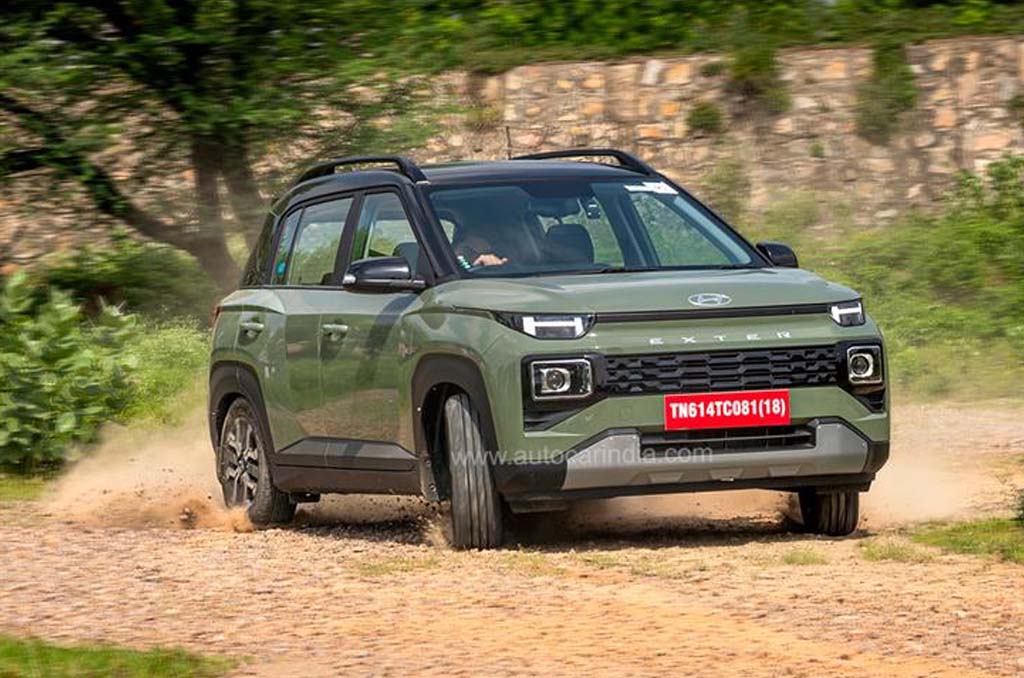Despite being a small-size A-segment car, the Hyundai Exter still possesses a ton of equipment to attract customers and outperform its competitors Sonet and Wigo.
The low rumble wave has passed and now manufacturers are racing to release high-riding car models to attract customers. This trend is not only sweeping through many different markets around the world, but also happening in Vietnam, with a series of high-riding names from the lowest segment like: VinFast VF 5, Kia Sonet…
Of course, the Korean brand Hyundai can’t stay out of the game. Specifically, in the Indian market, Hyundai Tata joint venture has launched the latest urban high-riding car named Exter – which is a formidable competitor to its compatriot Kia Sonet. It is highly likely that Thanh Cong Group will also soon import this small high-riding model to Vietnam, similar to previous actions with i10 or Creta. But before that, let’s see how Indian experts evaluate this car.
Firstly, it is important to note that Hyundai Exter is the “power supplement” model that maintains sales for the Grand i10 – as the trend of using high-riding cars is becoming more popular, while the sales of hatchback or sedan models are declining. The car is sold with prices ranging from 600,000 – 932,000 Rupee (equivalent to about 172 – 266 million VND) with options for petrol or CNG liquefied gas engines; with manual or automatic transmissions. This is a very reasonable price segment with a lot of potential for a small high-riding car.
Not only different in design, the style of this small urban high-riding car also has a big difference. Targeting young customers with aesthetic tastes, Hyundai Exter is also molded in a square, strong, and modern SUV style with many fresh features.
First of all, we must mention the very familiar H-shaped demi LED headlight cluster – which makes Hyundai Exter known as “mini Santa Fe” alongside its boxy appearance. Similar to the Kona or Santa Fe siblings, Hyundai Exter is arranged with the main lighting cluster below, arranged vertically.
The square grille with a large area is decorated with modern honeycomb details. The layered design makes the front appearance of Hyundai Exter become sturdy, strong and solid despite its compact size.
The body of Hyundai Exter is quite tall with a ground clearance of 185 mm. The car’s “legs” use 15-inch double-spoke wheels designed in two extremely modern and beautiful colors. The car body is surrounded by black textured plastic side skirts. The front and rear of the car are equipped with eye-catching gray splitters.
Unlike the i10 siblings, Hyundai Exter has a standing C-pillar, and the windows are very square – both create a sense of sportiness and increase interior space for rear passengers. The roof is also equipped with convenient roof racks and a shark fin antenna.
The design of the rear of Hyundai Exter is simplified and absolutely similar to the front. The brake lights are also arranged in the shape of an H. Below are the rear parking sensors, accompanying the reverse camera.
In India, Hyundai Exter is developed on the shared chassis platform with the Grand i10 Nios and has an overall width of 3.8m. The car is shorter, shorter and narrower than the hatchback version, but the wheelbase is increased by 5mm to 2,450mm. Combined with the boxy design, it can be said that Hyundai Exter has a very spacious interior compared to competitors in the same segment.
Entering the interior of the car, consumers will surely be very familiar with Hyundai Exter. Because the entire design and interior equipment on the A-segment hatchback i10 model is “upgraded” to Exter: from the steering wheel, dashboard, screen… Although they are all plastic materials, the finishing quality is very good, giving a solid, not “cheap” feeling.
Especially, the steering wheel of Hyundai Exter and the gear lever are wrapped in leather, giving a high-end gripping feeling. Some other equipment such as the instrument cluster behind the steering wheel in the form of a screen, 8-inch entertainment screen integrated with Apple CarPlay / Android Auto, wireless charging, type-C port, LED lights, cruise control, or sunroof are also things that competitors in the same segment are beaten by Exter.
With people of average height (around 1.7m or shorter), the space of Hyundai Exter is quite spacious. The seats hug the body and give a comfortable feeling. The Korean engineers were also very clever when designing the rear seat with a sloping seat and backrest, making the sitting posture of rear passengers very comfortable.
There is a spacious legroom, knees are far away from the front seat. However, with the limitation of a cheap model, Hyundai Exter lacks armrests for both the front and rear seats. In return, this small high-riding car is equipped with both a vent and a charging port for the second row. There are also many convenient and spacious storage compartments around the car.
The luggage compartment behind the car has a volume of up to 391 L – making Hyundai Exter one of the largest luggage compartment models in the small high-riding segment. The rear seat can also be folded 60:40 to increase storage space when needed.
In India, Hyundai Exter is equipped with a 1.2L naturally aspirated 4-cylinder engine with a power of 82 horsepower and 114 Nm of torque. The real experience shows that although the specifications are not impressive, Hyundai Exter gives a very “stable” driving feeling thanks to the weight of the car of only 999kg – quite “slim”.
The throttle of Hyundai Exter is optimized to provide responsive feedback (priority to initial throttle) – very suitable for a small urban high-riding car. The acceleration feeling is also very smooth and comfortable, proving that the transmission is also finely tuned by the manufacturer.
Especially, the clutch pedal on the manual version of Hyundai Exter is very light, making shifting gears easy and somewhat sharp. The automatic transmission also operates very smoothly, making it difficult for the driver to perceive the jerking feeling when shifting gears. However, there is a noticeable pause when the car shifts gears when the driver presses the accelerator deeply.
As a high-riding car with a ground clearance of 185 mm; Hyundai Exter has been redesigned the suspension compared to the low-riding i10 version. When passing through speed bumps or potholes, the car “swallows” the oscillations quite quickly, smoothly and without creating uncomfortable feeling.
Also thanks to the extended wheelbase, the driving feeling of Hyundai Exter is improved compared to the low-riding version. When driving on highways or turning, the car brings a more solid feeling than the low-riding version. Meanwhile, the Exter steering wheel is also very light, easy to control, and has a good turning radius. Of course, this is only an observation when comparing with cars in the same segment.
With such advantages: beautiful design, spacious space, generous equipment, smooth and comfortable driving feeling, and especially the reasonable price; clearly Hyundai Exter will be a very strong competitor if Thanh Cong brings it to Vietnam.
Anh Phan (Tuoitrethudo)
Source: AutoCar India




















































![[Quick Review] Ford Mustang: The Wild Horse with a Cowboy Spirit](https://vnauto.net/wp-content/uploads/2023/10/xehay-fordmustang-01092022-2-100x70.jpg)